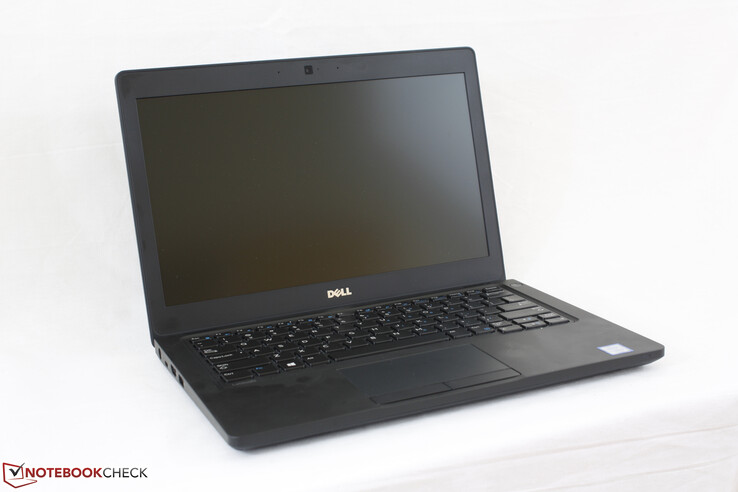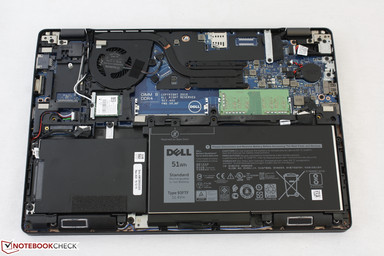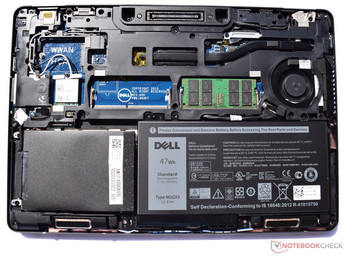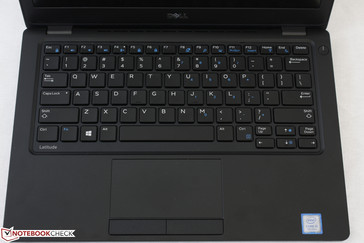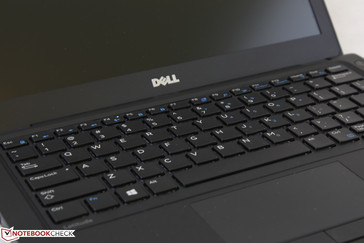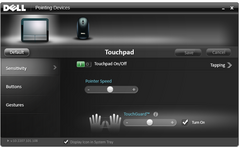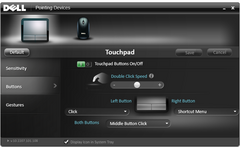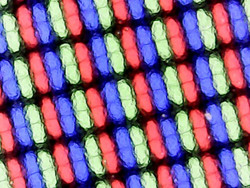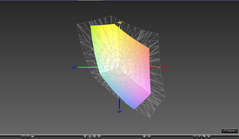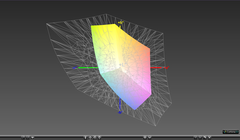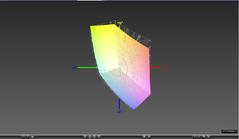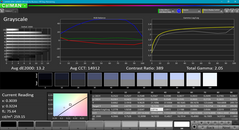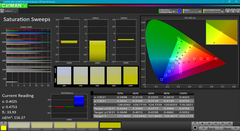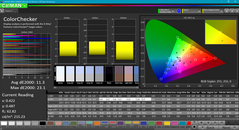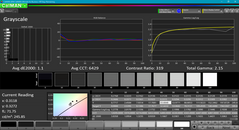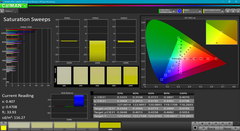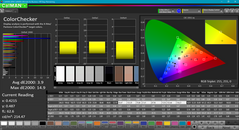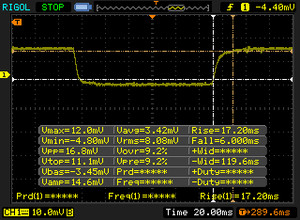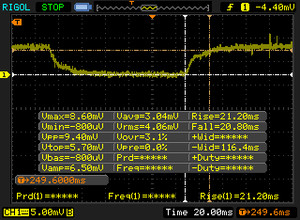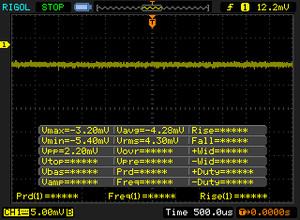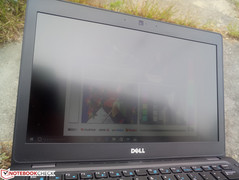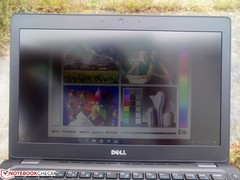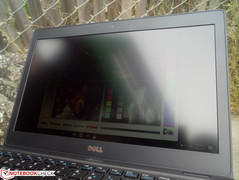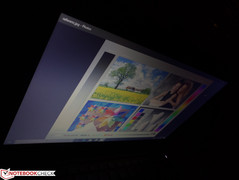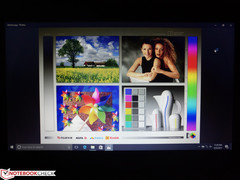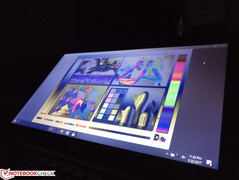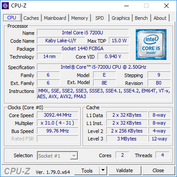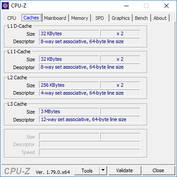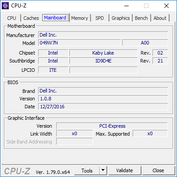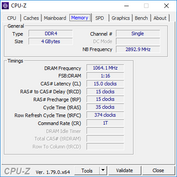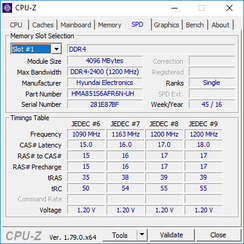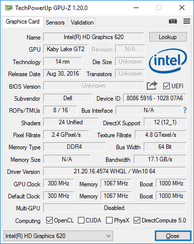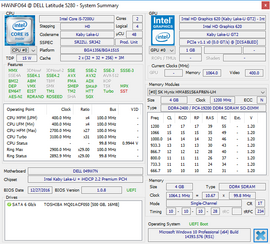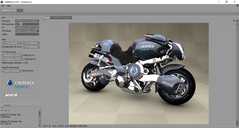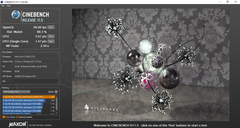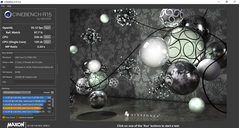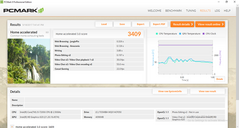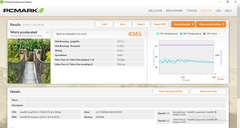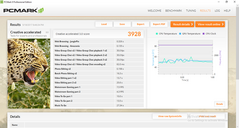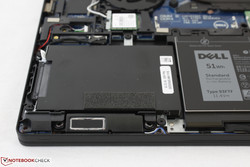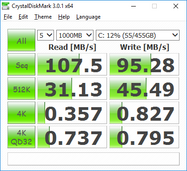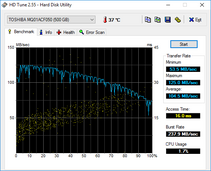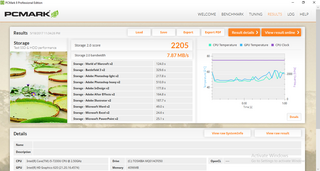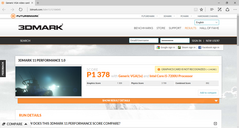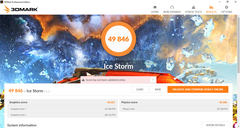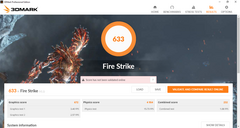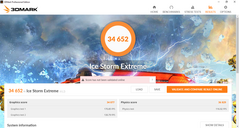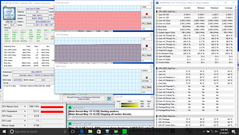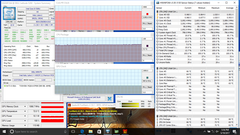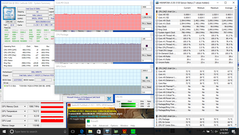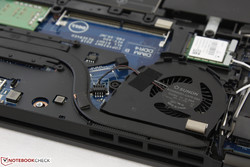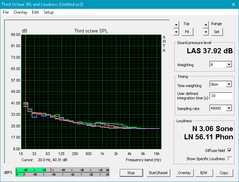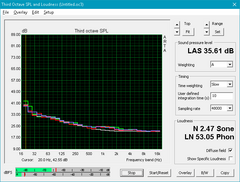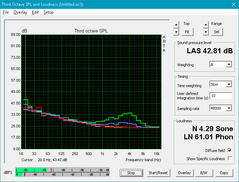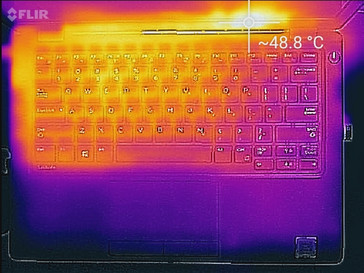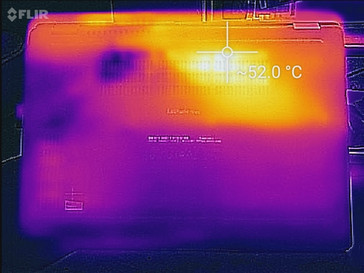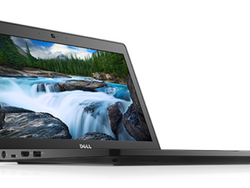Dell Latitude 5280 (7200U, HD) Laptop Review
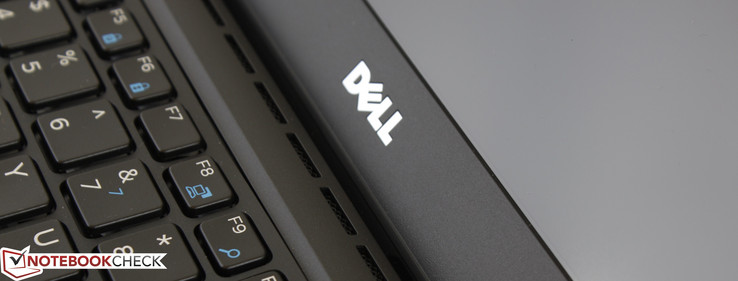
Like Lenovo, Dell has been slowly moving away from proprietary docking ports to universal USB Type-C and Thunderbolt 3 solutions on the latest Latitude series of business notebooks. This will inevitably alienate some existing users who have grown accustomed to specialized docks that connect to the bottom of the notebook, but the gains in portability and design from the move are hard to overlook.
The latest 12.5-inch Latitude 5280 notebook is an overhaul of the existing E5270 with notable improvements in both size and weight while sacrificing as few features as possible. The lowest-end SKU currently retails for $850 and ships with the i3-7100U, 500 GB HDD, 4 GB of RAM, and 768p display while the highest-end SKU ships with the i7-7600U CPU, M.2 NVMe SSD, 16 GB of RAM, Smart Card and fingerprint readers, and 1080p touchscreen display for well north of $1600 USD. Though we'll likely revisit the Latitude 5280 with a higher-end SKU in the future, our test unit today is on the lower-end of the spectrum with an i5-7200U CPU and 768p display retailing for about $950 USD.
We recommend checking out our existing review on the Latitude E5270 predecessor as the newer 5280 still shares many of the same features. Dell is marketing the Latitude 5280 as a direct competitor to the EliteBook 820 G4, ProBook 640 G3, ThinkPad 13, and ThinkPad X270.
Case
We praised the E5270 for its high quality plastic base reinforced with carbon fiber to increase rigidity. We're happy to report that the redesigned 5280 maintains this rigidity despite its thinner build. The base warps only very slightly when attempting to twist its sides and both the palm rests and keyboard center barely depress when applying pressure. The lid is more susceptible to bending and warping front its front two corners, but it is overall more rigid than on most Ultrabooks and is not unlike the lid of the XPS 13. The 180-degree hinges return and exhibit almost no teetering when typing or opening the lid.
Construction quality is perfect from top to bottom and we expected no less from a Latitude notebook. Our test unit exhibits no unintended gaps or crevices between materials with no notable weak spots from poor assembly or fragile latches. The chassis passes 15 MIL STD 810G benchmarks for durability against the elements not unlike the competition.
The 5280 is smaller and noticeably lighter (1.4 kg vs. 1.7 kg) than the outgoing E5270 for improved portability. Overall, however, its dimensions and weight are not significantly different than its immediate competitors from Lenovo or HP. We don't find this to be an issue especially for a business notebook as users who may prefer something thinner and more stylish are likely to lean towards an Ultrabook instead.
Connectivity
Dell has completely rearranged the positioning of the ports when compared to the older E5270. We find the arrangement to be an improvement as the commonly used ports are now on the left- and right-hand sides of the notebook for easier access whereas the E5270 had half of its ports on the rear.
Aside from the omission of the E-Port on the bottom, the 5280 still carries all of the connectivity features of the E5270 but with one less USB Type-A port. In its place is the more modern USB Type-C port with DisplayPort support as standard. The Smart Card reader remains optional while micro-SIM support is standard across all SKUs.
SD Card Reader
The uncovered spring-loaded MicroSD reader is on the rear of the notebook and can be quite difficult to access without first closing the lid and lifting the entire unit. Transfer rates are good with our Toshiba THN-M401S0640E2 test card at over 90 MB/s, though this pales in comparison to the full-size SD card reader of the XPS 15 at over 250 MB/s. Copying images to desktop is made even slower due to the primary HDD, so users running the notebook on a primary SSD should see faster results than our recorded 45 MB/s below.
| SD Card Reader | |
| average JPG Copy Test (av. of 3 runs) | |
| Lenovo ThinkPad X270-20HMS00T00 | |
| HP EliteBook 725 G4 | |
| Dell Latitude 5280 | |
| maximum AS SSD Seq Read Test (1GB) | |
| Dell Latitude 5280 | |
| Lenovo ThinkPad X270-20HMS00T00 | |
| HP EliteBook 725 G4 | |
Communication
Latitude 5280 SKUs can include either the 2x2 Intel 8265 or 2x2 Qualcomm QCA6174 for 802.11ac, WiGig, and integrated Bluetooth 4.2. Real-world transfer rates when standing one meter away from our Linksys EA8500 test router average 650 Mbps against a theoretical maximum of 867 Mbps. We experienced no latency or dropout issues during our time with the test unit.
WWAN is supported through the optional Snapdragon X7 LTE-A M.2 2240 module with Sprint, Verizon, T-Mobile, and AT&T compatibility. Note that the WWAN antennae are included even if users do not pre-configure with the Snapdragon X7 module, so end-users can easily install a WAN module if need be. Integrated NFC is not available on the Latitude 5280 but is optional on the larger Latitude 5580.
| Networking | |
| iperf3 transmit AX12 | |
| Lenovo ThinkPad X270-20HMS00T00 | |
| Dell Latitude 5289 | |
| Dell Latitude 5280 | |
| iperf3 receive AX12 | |
| Lenovo ThinkPad X270-20HMS00T00 | |
| Dell Latitude 5280 | |
| Dell Latitude 5289 | |
Security
The system supports vPro, Smart Card, and fingerprint reader alongside specialized ControlVault and Windows Hello software through the infrared camera. Most of these are optional, however, so users will have to pay a little extra to better protect their data.
Accessories
There are no included accessories in the box outside of the AC adapter and Quick Start guide. Owners will now need to rely on USB docking stations since the E-Port on the bottom has been removed for this latest iteration. This makes the lack of any Thunderbolt 3 options harder to swallow as the docking abilities of this notebook is more limited compared to the E5270.
Maintenance
Easy serviceability has always been a major selling point of business laptops and the Latitude 5280 is no different. A standard Philips screwdriver and sharp edge will pop open the bottom panel to reveal two storage bays, the M.2 2232 WLAN module, M.2 2240 WWAN slot, batteries, and both DDR4 SODIMM slots. When compared to the older Latitude 5270, the redesigned 5280 is significantly cleaner in terms of layout.
Warranty
The standard one-year limited warranty is included with options to extend coverage for up to five years. Separate warranties are also available for accidental damage, battery servicing, and hard drive recovery. Please see our Guarantees, Return policies and Warranties FAQ for country-specific information.
Input Devices
Keyboard
The chiclet keyboard (~26 x 10.5 cm) is quite small as expected from a notebook this size, but it feels especially small on the 5280 as Dell has left wide margins between the edges of the keyboard and the edges of the notebook. Typing feels more cramped than it should be as a result and the keys themselves feel rather heavy to press. Combine this with the spongy feedback and the typing experience feels subpar overall. Travel is adequate and the keys are relatively quiet, so users who can grow accustomed to the feel of the keyboard will appreciate the quieter clatter.
A two-level white backlight is optional and will cost users an extra $35 USD on top of the base price. The keyboard is not spill proof unlike on select Lenovo systems.
Touchpad
The small trackpad (10 x 5.5 cm) is slightly roughened in texture compared to the smoother palm rests. Basic cursor control is responsive and accurate with no jittering even if gliding slowly across the trackpad surface slowly. Its surface barely warps when applying heavy pressure with a finger for a uniform and stable performance from corner to corner. Grease will accumulate quickly and aging 5280 units will invariably suffer from oily surfaces over time, but there's very little to complain in terms of functionality. A traditional TrackPoint would have been a great addition for those who may prefer it over the touchpad.
The two dedicated mouse keys are very quiet and soft in feedback with relatively deep travel considering the small size of the notebook. The spongy feedback may take some getting used to, but this is still much more comfortable to use than a trackpad with integrated mouse keys.
Display
Current SKUs have the option of either 768p or 1080p. Our test unit is equipped with the former and this wouldn't have been so bad if the panel was decent, but our measurements below show mixed results all around. Colors have not improved from the outgoing E5270 and contrast is even worse than before at a paltry 336:1. Granted, the backlight is brighter this time around at an average of 250 nits compared to Dell's advertised promise of 200 nits. Unfortunately, nothing else has improved beyond the backlight intensity. The AU Optronics B125XTN panel here can be found on the much older Latitude E6220 and the budget-grade Lenovo IdeaPad U260. Not coincidentally, colors and contrast on these systems are also very poor.
Subjectively, texts are crisp while images look washed out especially when compared to the displays on the latest Ultrabooks. The low PPI leads to a noticeable screen-door effect and onscreen content suffers from a slight graininess as a result. Note that our impressions and measurements reflect only the 768p configuration and that the higher-end 1080p option will likely be a completely different experience altogether. Dell is promising that the 1080p non-touch option to be brighter at 300 nits while the highest-end 1080p Gorilla Glass touchscreen option will be even brighter at up to 360 nits.
| |||||||||||||||||||||||||
Brightness Distribution: 90 %
Center on Battery: 251.8 cd/m²
Contrast: 336:1 (Black: 0.75 cd/m²)
ΔE ColorChecker Calman: 11.3 | ∀{0.5-29.43 Ø4.78}
ΔE Greyscale Calman: 13.2 | ∀{0.09-98 Ø5}
59.2% sRGB (Argyll 1.6.3 3D)
37.6% AdobeRGB 1998 (Argyll 1.6.3 3D)
40.67% AdobeRGB 1998 (Argyll 3D)
59.2% sRGB (Argyll 3D)
39.34% Display P3 (Argyll 3D)
Gamma: 2.05
CCT: 14912 K
| Dell Latitude 5280 TN LED, 12.5", 1366x768 | Dell Latitude 5289 BOE NV12N51, IPS LED, 12.5", 1920x1080 | Lenovo ThinkPad X270-20HMS00T00 Innolux N125HCE-GN1, IPS LED, 12.5", 1920x1080 | HP EliteBook 725 G4 AU Optronics, IPS, 12.5", 1920x1080 | Dell Latitude 12 E5270 BOE05F4, TN, 12.5", 1366x768 | |
|---|---|---|---|---|---|
| Display | 9% | 12% | 24% | -1% | |
| Display P3 Coverage (%) | 39.34 | 42.79 9% | 44.6 13% 44.6 13% | 49.16 25% | 39.06 -1% |
| sRGB Coverage (%) | 59.2 | 64.3 9% | 65.9 11% 65.9 11% | 72.3 22% | 58.7 -1% |
| AdobeRGB 1998 Coverage (%) | 40.67 | 44.21 9% | 46.11 13% 46.11 13% | 50.8 25% | 40.36 -1% |
| Response Times | -17% | -14% | -8% | -6% | |
| Response Time Grey 50% / Grey 80% * (ms) | 42 ? | 42 ? -0% | 40.8 ? 3% | 47 ? -12% | 45.2 ? -8% |
| Response Time Black / White * (ms) | 23.2 ? | 31 ? -34% | 30.4 ? -31% | 24 ? -3% | 24 ? -3% |
| PWM Frequency (Hz) | 531 ? | 26040 ? | 1000 ? | ||
| Screen | 55% | 49% | 81% | 9% | |
| Brightness middle (cd/m²) | 251.8 | 336 33% | 283 12% | 329 31% | 161 -36% |
| Brightness (cd/m²) | 246 | 320 30% | 281 14% | 310 26% | 152 -38% |
| Brightness Distribution (%) | 90 | 90 0% | 94 4% | 88 -2% | 90 0% |
| Black Level * (cd/m²) | 0.75 | 0.34 55% | 0.25 67% | 0.19 75% | 0.29 61% |
| Contrast (:1) | 336 | 988 194% | 1132 237% | 1732 415% | 555 65% |
| Colorchecker dE 2000 * | 11.3 | 3.45 69% | 6.1 46% | 2.69 76% | 10.31 9% |
| Colorchecker dE 2000 max. * | 23.1 | 7.95 66% | 15.4 33% | 4.47 81% | 18.58 20% |
| Greyscale dE 2000 * | 13.2 | 1.68 87% | 6 55% | 4.23 68% | 11.3 14% |
| Gamma | 2.05 107% | 2.49 88% | 2.05 107% | 2.21 100% | 2.57 86% |
| CCT | 14912 44% | 6782 96% | 6832 95% | 6011 108% | 13574 48% |
| Color Space (Percent of AdobeRGB 1998) (%) | 37.6 | 41 9% | 42.26 12% | 46 22% | 37.32 -1% |
| Color Space (Percent of sRGB) (%) | 59.2 | 64 8% | 65.43 11% | 72 22% | 58.82 -1% |
| Total Average (Program / Settings) | 16% /
36% | 16% /
30% | 32% /
58% | 1% /
5% |
* ... smaller is better
Color coverage is approximately 59 percent and 38 percent of the sRGB and AdobeRGB standards, respectively. This is indicative of a budget panel more fit for an inexpensive netbook than on a Latitude where prices can easily reach over $1000 USD. Fortunately, full sRGB coverage is not necessary for owners who will simply use the notebook for word processing and browsing. Newer multimedia machines and most Ultrabooks like the recent XPS 13/15 series offer wider gamuts if color accuracy is a concern.
Like the Latitude 5580, the 768p display of the 5280 is in dire need of calibration out of the box. Color temperature is much too cool and colors are subsequently very inaccurate as a result. We highly recommend calibrating the display as both grayscale and colors improve significantly as shown by our CalMan measurements below. Reds and Blues are the most inaccurate out of all the primary and secondary colors for this particular panel. Accuracy decreases at higher saturation levels due to the imperfect sRGB coverage of the panel.
Display Response Times
| ↔ Response Time Black to White | ||
|---|---|---|
| 23.2 ms ... rise ↗ and fall ↘ combined | ↗ 17.2 ms rise | |
| ↘ 6 ms fall | ||
| The screen shows good response rates in our tests, but may be too slow for competitive gamers. In comparison, all tested devices range from 0.1 (minimum) to 240 (maximum) ms. » 52 % of all devices are better. This means that the measured response time is worse than the average of all tested devices (20.2 ms). | ||
| ↔ Response Time 50% Grey to 80% Grey | ||
| 42 ms ... rise ↗ and fall ↘ combined | ↗ 21.2 ms rise | |
| ↘ 20.8 ms fall | ||
| The screen shows slow response rates in our tests and will be unsatisfactory for gamers. In comparison, all tested devices range from 0.165 (minimum) to 636 (maximum) ms. » 66 % of all devices are better. This means that the measured response time is worse than the average of all tested devices (31.6 ms). | ||
Screen Flickering / PWM (Pulse-Width Modulation)
| Screen flickering / PWM not detected | |||
In comparison: 53 % of all tested devices do not use PWM to dim the display. If PWM was detected, an average of 8111 (minimum: 5 - maximum: 343500) Hz was measured. | |||
Outdoor visibility continues to be poor as the display backlight is not powerful enough to overcome glare. Colors become washed out even on an overcast day and the TN panel significantly limits viewing angles. The 1080p IPS options should make better use of the wide 180-degree hinges to provide a superior experience when outdoors.
Performance
CPU options are limited to the ULV U-class Kaby Lake processors whereas the larger 14-inch Latitude 5480 and 15.6-inch Latitude 5580 series can be configured with HQ-class processors. GPU options are also limited to the integrated HD Graphics 620 and so the 12.5-inch 5280 is clearly marketed for lighter workloads not unlike most Ultrabooks. Users can pre-configure with Ubuntu 16.04 instead of Windows 10 if desired.
Processor
CPU performance is where we expect it to be for an i5-7200U. CineBench scores are essentially the same as on our identically configured Latitude 5580. Users can expect a performance uptick of about 6 percent over the Skylake i5-6300U or even higher for single-threaded workloads. Indecisive buyers should note that the highest-end SKU of the Latitude 5280 with the i7-7600U is just marginally faster in multi-threaded workloads than the i5-7200U whereas the jump from the i3-7100U to the i5-7200U is more significant.
Running CineBench R15 Multi-Thread in a loop exhibits no drops in scores over time or notable CPU throttling issues. See our dedicated CPU page on the i5-7200U for more technical information and benchmark comparisons.
| wPrime 2.10 - 1024m | |
| Lenovo Thinkpad 13-20J1001BUS | |
| Dell Latitude E7470 N001LE747014EMEA | |
| Dell Latitude 7280 | |
| HP EliteBook 725 G4 | |
| Dell Latitude 5580 | |
| Dell Latitude 5280 | |
| Lenovo ThinkPad T470s-20HF0012US | |
* ... smaller is better
System Performance
PCMark 8 scores are in the same ballpark as competing notebooks including the ThinkPad X270. The system is able to consistently outscore the E5270 just marginally while holding a wider lead against the AMD-powered ProBook 725 G4.
We experienced no software issues during our time with the 5280 test unit. OS responsiveness is slow due to the primary mechanical drive.
| PCMark 8 | |
| Home Score Accelerated v2 | |
| Lenovo ThinkPad X270-20HMS00T00 | |
| Dell Latitude 5289 | |
| Dell Latitude 5280 | |
| Dell Latitude 12 E5270 | |
| HP EliteBook 725 G4 | |
| Work Score Accelerated v2 | |
| Dell Latitude 5289 | |
| Lenovo ThinkPad X270-20HMS00T00 | |
| Dell Latitude 5280 | |
| Dell Latitude 12 E5270 | |
| HP EliteBook 725 G4 | |
| Creative Score Accelerated v2 | |
| Dell Latitude 5280 | |
| Dell Latitude 12 E5270 | |
| HP EliteBook 725 G4 | |
| PCMark 8 Home Score Accelerated v2 | 3409 points | |
| PCMark 8 Creative Score Accelerated v2 | 3928 points | |
| PCMark 8 Work Score Accelerated v2 | 4365 points | |
Help | ||
Storage Devices
Two internal storage bays are available for accepting either a 2.5-inch SATA III drive or an M.2 2280 NVMe SSD. It's important to note that the M.2 slot occupies the same space as the 2.5-inch SATA bay, so users cannot utilize both simultaneously. Furthermore, we recommend sticking to 7 mm thick 2.5-inch drives as 9.5 mm drives may be too tight of a squeeze.
The 500 GB Toshiba MQ01ACF050 HDD in our test configuration returns a respectable transfer rate of 104 MB/s according to HD Tune. This is average for a 7200 RPM drive whereas slower 5400 RPM drives are normally under 90 MB/s in the same benchmark test. Of course, this pales in comparison to NVMe SSDs or even SATA III SSDs as shown by our table below, so investing in a primary SSD may be worthwhile for significantly improved system responsiveness.
See our growing table of HDDs and SSDs for more benchmark comparisons.
| Dell Latitude 5280 Toshiba MQ01ACF050 | Dell Latitude 5289 SanDisk X400 256GB, SATA (SD8SB8U-256G) | Lenovo ThinkPad X270-20HMS00T00 Toshiba NVMe THNSF5512GPUK | HP EliteBook 725 G4 Samsung PM961 MZVLW256HEHP | Dell Latitude 12 E5270 Seagate ST500LM021-1KJ15 | |
|---|---|---|---|---|---|
| CrystalDiskMark 3.0 | 9086% | 18752% | 6641% | -1% | |
| Read Seq (MB/s) | 107.5 | 423.7 294% | 1190 1007% | 1963 1726% | 113.8 6% |
| Write Seq (MB/s) | 95.3 | 406.4 326% | 985 934% | 1409 1378% | 108.5 14% |
| Read 512 (MB/s) | 31.13 | 260.8 738% | 858 2656% | 949 2949% | 24.9 -20% |
| Write 512 (MB/s) | 45.49 | 255.6 462% | 528 1061% | 890 1856% | 51.9 14% |
| Read 4k (MB/s) | 0.357 | 22.73 6267% | 35.27 9780% | 29.75 8233% | 0.398 11% |
| Write 4k (MB/s) | 0.827 | 27.92 3276% | 124.5 14954% | 47.35 5626% | 0.654 -21% |
| Read 4k QD32 (MB/s) | 0.737 | 306.2 41447% | 495.3 67105% | 139.7 18855% | 0.798 8% |
| Write 4k QD32 (MB/s) | 0.795 | 158.8 19875% | 418.3 52516% | 100.2 12504% | 0.636 -20% |
GPU Performance
The integrated HD Graphics 620 is only about 11 percent faster than the passively-cooled HD Graphics 615 in the XPS 13 9365 according to 3DMark 11. Opting for the higher-end Latitude 5280 SKU with the i7-7600U will bump GPU performance by 26 percent over the i5-7200U, but this is still underwhelming and not powerful enough to play most modern titles at respectable graphical settings. Otherwise, performance is nearly identical to the similarly equipped Latitude 5580.
See our dedicated GPU page on the HD Graphics 620 for more technical information and gaming benchmarks.
| 3DMark | |
| 1280x720 Cloud Gate Standard Graphics | |
| Intel Skull Canyon NUC6i7KYK | |
| Dell Latitude 7480 | |
| Acer Swift 3 SF314-51-731X | |
| Dell Latitude 5280 | |
| Dell Latitude 5580 | |
| Lenovo Yoga 900S-12ISK-80ML | |
| 1920x1080 Fire Strike Graphics | |
| Intel Skull Canyon NUC6i7KYK | |
| Dell Latitude 7480 | |
| Dell Latitude 5280 | |
| Dell Latitude 5580 | |
| Lenovo Yoga 900S-12ISK-80ML | |
| 1920x1080 Ice Storm Extreme Graphics | |
| Intel Skull Canyon NUC6i7KYK | |
| Dell Latitude 7480 | |
| Dell Latitude 5280 | |
| Dell Latitude 5580 | |
| Lenovo Yoga 900S-12ISK-80ML | |
| 3DMark 11 Performance | 1378 points | |
| 3DMark Ice Storm Standard Score | 49846 points | |
| 3DMark Cloud Gate Standard Score | 5281 points | |
| 3DMark Fire Strike Score | 633 points | |
Help | ||
| low | med. | high | ultra | |
|---|---|---|---|---|
| BioShock Infinite (2013) | 29.9 | 20.9 | 18 | |
| Rise of the Tomb Raider (2016) | 14 |
Stress Test
We stress the notebook with unrealistic loads in order to identify for any potential throttling or hardware issues. When under Prime95 load, the CPU can be observed maintaining a Turbo Boost clock rate of 3.1 GHz and a core temperature in the 73 C range. This is the maximum advertised clock rate for the i5-7200U and is impressive to see since many notebooks with ULV processors will typically limit Turbo Boost clock rates to preserve lower core temperatures or power consumption. Running both Prime95 and FurMark will drop CPU clock rate to 2.6 GHz while the integrated GPU operates at a steady 998 MHz. Core temperature appears to plateau at a reasonable 75 C.
Running on battery power will not throttle CPU or GPU performance. A 3DMark 11 run on batteries returns Physics and GPU scores of 3713 and 1306 points, respectively, compared to 3709 and 1309 points when on mains. Thus, users can expect to have the full performance out of the notebook even if away from an outlet.
| CPU Clock (GHz) | GPU Clock (MHz) | Average CPU Temperature (°C) | |
| Prime95 Stress | 3.1 | -- | 73 |
| FurMark Stress | -- | 998 | 72 |
| Prime95 + FurMark Stress | 2.6 | 998 | 75 |
Emissions
System Noise
We were hoping for improved fan characteristics but fan noise remains nearly identical to last year's E5270. That is, the fan is always active no matter the system load with no "Silent Mode" option available. In comparison, competing notebooks like the ThinkPad X270 or EliteBook 725 G4 are silent during low loads. To Dell's credit, however, the fan here is largely constant and apathetic even when under 3DMark 06 loads. Thus, while fan noise is always present, users are less likely to notice any unsteady pulsing. The redesign has also moved the ventilation grilles to the rear of the notebook instead of to the side as on the E5270.
Extreme loads with Prime95 and FurMark will bump fan noise up to 34.2 dB(A) and finally 37 dB(A). This maximum recorded fan noise is not representative of daily workloads and so users can expect the fan to remain below 34 dB(A) when browsing and word processing. The mechanical drive is audible when seeking and users may want to configure with a primary SSD to avoid the noise. We can otherwise notice no coil whine on our particular test unit during use.
Noise level
| Idle |
| 32.6 / 32.7 / 32.7 dB(A) |
| HDD |
| 33 dB(A) |
| Load |
| 33.4 / 37 dB(A) |
 | ||
30 dB silent 40 dB(A) audible 50 dB(A) loud |
||
min: | ||
| Dell Latitude 5280 HD Graphics 620, i5-7200U, Toshiba MQ01ACF050 | Dell Latitude 5289 HD Graphics 620, i5-7300U, SanDisk X400 256GB, SATA (SD8SB8U-256G) | Lenovo ThinkPad X270-20HMS00T00 HD Graphics 620, i5-7200U, Toshiba NVMe THNSF5512GPUK | HP EliteBook 725 G4 Radeon R7 (Bristol Ridge), PRO A12-9800B, Samsung PM961 MZVLW256HEHP | Dell Latitude 12 E5270 HD Graphics 520, 6300U, Seagate ST500LM021-1KJ15 | |
|---|---|---|---|---|---|
| Noise | 1% | 3% | 4% | -1% | |
| off / environment * (dB) | 27.6 | 30.5 -11% | 29 -5% | 30.4 -10% | 29.2 -6% |
| Idle Minimum * (dB) | 32.6 | 30.5 6% | 29 11% | 30.4 7% | 32.9 -1% |
| Idle Average * (dB) | 32.7 | 30.5 7% | 29 11% | 30.4 7% | 32.9 -1% |
| Idle Maximum * (dB) | 32.7 | 30.5 7% | 30.4 7% | 30.4 7% | 32.9 -1% |
| Load Average * (dB) | 33.4 | 36 -8% | 34.1 -2% | 31.7 5% | 33.7 -1% |
| Load Maximum * (dB) | 37 | 34.6 6% | 37.6 -2% | 34.4 7% | 34.9 6% |
* ... smaller is better
Temperature
Surface temperature when idling are flat on both sides of the notebook save for its right palm rest since the 2.5-inch HDD is directly underneath. This spot can be as warm as 30 C even when the system is otherwise idle compared to 24 C on the left palm rest. Users who configure with a primary SATA III SSD in lieu of a mechanical drive will likely not experience as high of a surface temperature discrepancy between the two palm rests. NVMe SSDs, however, are known to be quite warm when active and may lead to a warmer palm rest.
When under extreme loads, the left side of the notebook will become warmer than the right due to the placement of the processor underneath. Surface temperatures never become uncomfortably warm for typing and the palm rests remain comparatively cool no matter the system load. In comparison, the keyboard keys on the ThinkPad X1 Carbon can be as warm as 44 C under similar high loads.
(-) The maximum temperature on the upper side is 48.4 °C / 119 F, compared to the average of 35.9 °C / 97 F, ranging from 21.4 to 59 °C for the class Subnotebook.
(-) The bottom heats up to a maximum of 49.2 °C / 121 F, compared to the average of 39.3 °C / 103 F
(+) In idle usage, the average temperature for the upper side is 25 °C / 77 F, compared to the device average of 30.8 °C / 87 F.
(+) The palmrests and touchpad are cooler than skin temperature with a maximum of 28.4 °C / 83.1 F and are therefore cool to the touch.
(±) The average temperature of the palmrest area of similar devices was 28.2 °C / 82.8 F (-0.2 °C / -0.3 F).
Speakers
The stereo speakers come equipped with the same Waves MaxxAudio Pro equalizer software as do the recent XPS 13 and 15 notebooks. Perhaps coincidentally, audio quality is not unlike the XPS 13/15 or even the Latitude 5580, which is good for a notebook this small. Maximum volume is sufficiently loud with a sharp drop off at about 125 Hz because of limited bass reproduction. It's important to activate the equalizer and turn up the "MaxxBass" setting or else maximum volume will be significantly quieter. Our pink noise measurement below was performed only after activating these custom settings. High volume settings will not introduce any static, but treble is over-represented and the palm rests will reverberate just slightly to the touch.
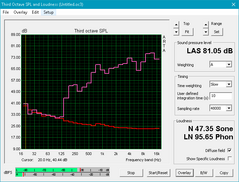
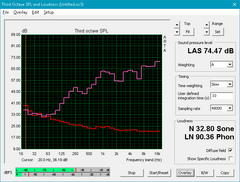
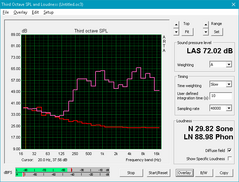
Dell Latitude 5280 audio analysis
(±) | speaker loudness is average but good (81.1 dB)
Bass 100 - 315 Hz
(-) | nearly no bass - on average 20.2% lower than median
(±) | linearity of bass is average (12.4% delta to prev. frequency)
Mids 400 - 2000 Hz
(+) | balanced mids - only 4% away from median
(±) | linearity of mids is average (9.5% delta to prev. frequency)
Highs 2 - 16 kHz
(±) | higher highs - on average 5.8% higher than median
(±) | linearity of highs is average (9.8% delta to prev. frequency)
Overall 100 - 16.000 Hz
(±) | linearity of overall sound is average (25.4% difference to median)
Compared to same class
» 85% of all tested devices in this class were better, 3% similar, 12% worse
» The best had a delta of 5%, average was 18%, worst was 53%
Compared to all devices tested
» 77% of all tested devices were better, 5% similar, 18% worse
» The best had a delta of 4%, average was 24%, worst was 134%
Apple MacBook 12 (Early 2016) 1.1 GHz audio analysis
(+) | speakers can play relatively loud (83.6 dB)
Bass 100 - 315 Hz
(±) | reduced bass - on average 11.3% lower than median
(±) | linearity of bass is average (14.2% delta to prev. frequency)
Mids 400 - 2000 Hz
(+) | balanced mids - only 2.4% away from median
(+) | mids are linear (5.5% delta to prev. frequency)
Highs 2 - 16 kHz
(+) | balanced highs - only 2% away from median
(+) | highs are linear (4.5% delta to prev. frequency)
Overall 100 - 16.000 Hz
(+) | overall sound is linear (10.2% difference to median)
Compared to same class
» 7% of all tested devices in this class were better, 2% similar, 91% worse
» The best had a delta of 5%, average was 18%, worst was 53%
Compared to all devices tested
» 4% of all tested devices were better, 1% similar, 94% worse
» The best had a delta of 4%, average was 24%, worst was 134%
Frequency Comparison (Checkbox selectable!)
Graph 1: Pink Noise 100% Vol.; Graph 2: Audio off
Energy Management
Power Consumption
Don't expect power consumption to be a significant improvement over the previous E5270 during low to medium loads up to 3DMark 06. If running extreme processing loads, however, the 5280 will demand about 10 W less than our specific E5270 configuration.
The small external power adapter (~10.5 x 7 x 2.5 cm) is rated for 65 W or over twice the maximum power consumption for our particular SKU. Dell ships this same power adapter across all its Latitude 5280 configurations to ensure proper power delivery for the more demanding SKUs.
| Off / Standby | |
| Idle | |
| Load |
|
Key:
min: | |
| Dell Latitude 5280 i5-7200U, HD Graphics 620, Toshiba MQ01ACF050, TN LED, 1366x768, 12.5" | Dell Latitude 5289 i5-7300U, HD Graphics 620, SanDisk X400 256GB, SATA (SD8SB8U-256G), IPS LED, 1920x1080, 12.5" | Lenovo ThinkPad X270-20HMS00T00 i5-7200U, HD Graphics 620, Toshiba NVMe THNSF5512GPUK, IPS LED, 1920x1080, 12.5" | HP EliteBook 725 G4 PRO A12-9800B, Radeon R7 (Bristol Ridge), Samsung PM961 MZVLW256HEHP, IPS, 1920x1080, 12.5" | Dell Latitude 12 E5270 6300U, HD Graphics 520, Seagate ST500LM021-1KJ15, TN, 1366x768, 12.5" | |
|---|---|---|---|---|---|
| Power Consumption | 12% | -1% | 0% | 2% | |
| Idle Minimum * (Watt) | 5.7 | 2.7 53% | 3.5 39% | 4.5 21% | 3.9 32% |
| Idle Average * (Watt) | 6.9 | 5.1 26% | 5.8 16% | 6.3 9% | 6 13% |
| Idle Maximum * (Watt) | 7.1 | 7.6 -7% | 7.6 -7% | 8.3 -17% | 6.6 7% |
| Load Average * (Watt) | 28.3 | 33 -17% | 33.2 -17% | 27.6 2% | 28.9 -2% |
| Load Maximum * (Watt) | 30.2 | 29 4% | 40.4 -34% | 34.5 -14% | 41.7 -38% |
* ... smaller is better
Battery Life
Internal battery options include 42 Wh, 51 Wh, and 68 Wh options. As far as 12-inch notebooks are concerned, the 68 Wh SKU is one of the largest available on a business offering likely to make up for the lack of any secondary battery options on the new 5280 design.
Our particular test unit carries the 51 Wh battery for a real-world WLAN runtime of almost 8 hours without needing to recharge. This is over an hour longer than both the E5270 and AMD-powered EliteBook 725 G4 under similar testing conditions. Idling on desktop and on the minimum brightness setting will last for over 18 hours if users want to squeeze out even longer runtimes on more conservative system settings.
Recharging from near empty to full capacity will take about two hours. The smaller 42 Wh and larger 68 Wh battery options will likely carry shorter and longer recharge times, respectively.
| Dell Latitude 5280 i5-7200U, HD Graphics 620, 51 Wh | Dell Latitude 5289 i5-7300U, HD Graphics 620, 60 Wh | Lenovo ThinkPad X270-20HMS00T00 i5-7200U, HD Graphics 620, 46 Wh | HP EliteBook 725 G4 PRO A12-9800B, Radeon R7 (Bristol Ridge), 49 Wh | Dell Latitude 12 E5270 6300U, HD Graphics 520, 47 Wh | |
|---|---|---|---|---|---|
| Battery runtime | 36% | -22% | -22% | -18% | |
| Reader / Idle (h) | 18.5 | 28.8 56% | 17.1 -8% | 11.7 -37% | 12.9 -30% |
| WiFi v1.3 (h) | 7.8 | 11.8 51% | 5.4 -31% | 6.3 -19% | 6.6 -15% |
| Load (h) | 2.3 | 2.3 0% | 1.7 -26% | 2.1 -9% | 2.1 -9% |
Pros
Cons
Verdict
A key selling point of most business notebooks is the ability to easily connect docking stations or secondary battery packs. Now that the Latitude 5280/5480/5580 series has dropped the E-Port, Thunderbolt 3 is becoming even more crucial for supporting additional features. The Latitude 5280 unfortunately lacks both and is consequently less versatile than the 5480 and 5580 even though it is smaller and more portable. Additionally, the system fan is always active which we find to be unnecessary for a notebook sporting only U-class processors.
If the above disadvantages are not deal breakers, however, then the 5280 excels in most other categories. Its USB Type-C port will still output to DisplayPort external monitors and the new chassis is much lighter than the E5270 without being noticeably more fragile. Runtimes are already excellent on the mid-range battery option and preserving both VGA and HDMI outputs should prove useful in university and conference room settings. CPU performance in particular is impressive as the processor is able to sustain maximum Turbo Boost speeds even when under very high loads.
We highly recommend skipping the very poor 768p display in favor of the brighter 1080p option with faster primary SSDs. The boost in resolution and brightness will make the notebook more comfortable to use and are absolutely worth the investment if the system will be frequently used sans external monitors.
The somewhat spongy keyboard may take some getting used to and users with larger hands will want to avoid this particular size category for heavy typing. The 5280 is more for users constantly on the move than something to be constantly docked at home or in the office.
Dell Latitude 5280
- 05/27/2017 v6 (old)
Allen Ngo




